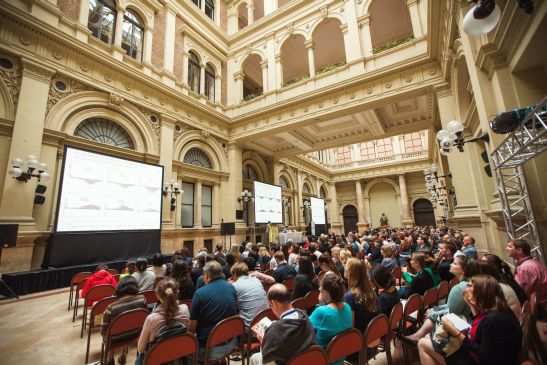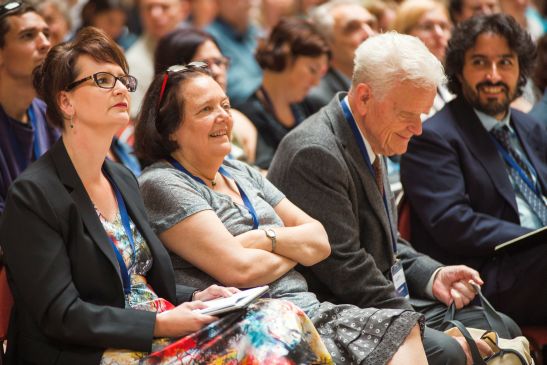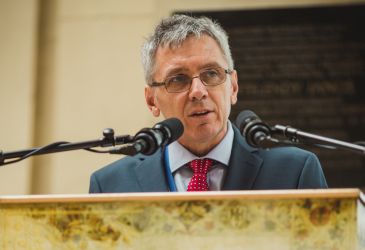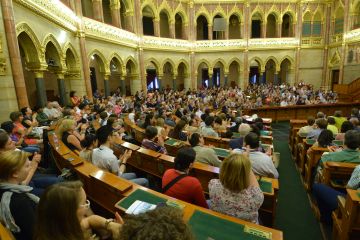European Population Conference 2014
The 12th conference of the European Association for Population Studies was organised in the summer of 2014, with a special focus on the demographic interpretation and evaluation of the post-communist transition. The conference took place between 25–28 June in Budapest, in the main building of the Corvinus University and the Upper House Hall of the Parliament. The local co-organiser of this year’s successful conference was the Hungarian Demographic Research Institute. Founded in 1983, the European Association for Population Studies (EAPS) is now one of the most significant international academic organisations of the demographic profession. Its biennial conferences attract speakers and audience from Europe and the other continents in considerable numbers.
|
Opening plenary in the Main Building of the Corvinus University |
Melinda Mills, France Meslé, Paul Demeny and Francesco Billari |
|
Zsolt Spéder |
Closing ceremony in the Parliament |
More picture about the Opening and Closing ceremony. The conference in pictures.
The conference was attended by nearly 900 registered participants, representing almost all European countries and 25 nations outside of Europe. There were over fifty participants from Germany, Great Britain, Spain and Italy. 21% of the participants arrived from Central and Eastern Europe. Besides Hungarians, this group of countries was most notably represented by Polish researchers (35 visitors), but the number of Czech and Russian demographers also exceeded twenty. Just under one fifth of the participants came from non-European countries. Among these, the largest groups were from the United States (56 participants), Canada (15 people) and Japan (11 people), but there were delegates from Uganda, Mali, Ghana, Singapore and Taiwan, only to mention a few.
In keeping with the traditions of EPCs, presentations covered all major subject areas of demography in the broadest sense, from statistical and methodological issues all the way to bio-demography. However, every conference also has a central theme – this time the event bore the sub-title Transitions: Opportunities and Threats. One plenary session and a number of regular sessions were dedicated to this featured topic.
At the opening plenary session David S. Reher (Madrid) spoke about the theory of demographic transition, the possible re-interpretation of this theory and the need for such re-visiting; Melinda Mills (Oxford) offered a new approach to examining family transitions in Europe, France Meslé (Paris) talked about mortality/health crisis in post-communist societies, while the presentation of Zsolt Spéder (Budapest) concerned an overlooked aspect of the Post-Communist Fertility Transition. One of the outstanding events of the conference was the plenary lecture given by the internationally acknowledged Hungarian demographer Paul Demeny, who proposed the possibility of deploying a new type of active demographic incentives in response to the worrying demographic situation in Europe.
The conference was paralleled by an impressive number of supplementary academic events. Thus, for instance, exhibition stands were dedicated to the leading demographic research institutes of the world (London, the Hague, Stockholm, Rostock, Paris, Barcelona, Wien, Wiesbaden), while the interactive demographic exhibition by the network ‘Population Europe’ was also presented to the professional community. The closing ceremony took place in the Upper House Hall of the Hungarian Parliament, and the awards of EAPS were also presented there. The laureate of the 2014 EAPS Award for Population Studies was the Belgian demographer Frans Willekens, who currently works in Germany.
About 530 presentations took place in the 116 session of 12 parallel sections, selected from no fewer than 1063 submitted abstracts. Thus, similarly to earlier EPC conferences, approximately half of the submitted papers were accepted for presentation at the Budapest event. The most abstracts were submitted from the US, followed by Spain, while the third place went to Germany. 43 abstracts were submitted by Hungarian first authors, which meant places 9–11 in the rank order of countries.
Table 1: Countries with the highest number of submitted abstracts (according to the first author’s place of residence)
|
Country |
Number of submitted abstracts |
|
|
1 |
United States of America |
101 |
|
2 |
Spain |
75 |
|
3 |
Germany |
68 |
|
4 |
Italy |
67 |
|
5 |
United Kingdom |
66 |
|
6 |
France |
53 |
|
7 |
Sweden |
52 |
|
8 |
Austria |
44 |
|
9 |
Hungary |
43 |
|
10 |
The Netherlands |
43 |
|
11 |
Belgium |
43 |
|
12 |
India |
38 |
|
13 |
Poland |
33 |
|
14 |
Czech Republic |
32 |
|
15 |
Russia |
25 |
It is worth examining the submitted abstracts from the perspective of their subject matter (Table 2), as this is a more accurate reflection of the current interests of the demographic community than the distribution of accepted papers, since the latter is also shaped by the set and pre-determined number of conference sessions. The most popular topics (with over one hundred titles) were ‘family and household’, ‘fertility’ and ‘international migration’. The submitted proposals indicate that the international migration processes which have increasingly affected Europe are now a very popular topic, but the demographic characteristics of Central and Eastern Europe and the challenge presented by aging populations for a growing number of countries also received considerable attention.
On the other hand, attention to the topics of ‘reproductive health’ and ‘historical demography’ is declining, compared to the tendencies and planned session structure of previous years, which means that most abstracts submitted to these themes were accepted.
Table 2. Subject areas of conference sessions, numbers of submitted and accepted abstracts
|
Subject area |
Number of submitted abstracts |
Number of accepted abstracts |
|
|
1 |
Fertility |
141 |
74 |
|
2 |
Sexual and reproductive health |
51 |
43 |
|
3 |
Families and households |
146 |
80 |
|
4 |
Life course |
64 |
35 |
|
5 |
Aging and intergenerational relations |
61 |
28 |
|
6 |
Internal migration and urbanisation |
59 |
29 |
|
7 |
International migration and migrant populations |
108 |
56 |
|
8 |
Health, well-being and morbidity |
80 |
35 |
|
9 |
Mortality and longevity |
77 |
43 |
|
10 |
History |
32 |
20 |
|
11 |
Data and methods |
54 |
30 |
|
12 |
Economics, human capital and labour market |
59 |
29 |
|
13 |
Policy issues |
63 |
35 |
|
14 |
Development and environment |
30 |
19 |
|
Total |
1063 |
556 |
|
Regarding the actual presentations, 12–16 sessions were organised in the top three topics, while the number of sessions was between 4 and 9 in the remaining nine subject areas. Besides oral presentations, poster sessions were also organized – as many as 250 posters were presented in three sessions.
The participation of Hungarian researchers was outstanding in the conference – 23 presentations had at least one author who worked in a Hungarian institution and in almost all such cases the Hungarian researcher acted as first author. Besides the Hungarian Demographic Research Institute, local participants represented institutions such as the Centre for Social Sciences at the Hungarian Academy of Sciences; the Hungarian Central Statistical Office, Eötvös Loránd University, Corvinus University of Budapest and Semmelweis University. Another ten presentations were given by Hungarian demographers working abroad. Further Hungarian researchers, policy makers and other interested visitors also actively participated in the conference – the number of registered Hungarian participants was just under one hundred.
For further information visit the conference website or the detailed programme.
New HDRI publications at the EPC:
- Working Papers on Population, Family and Welfare no. 19: Róbert I. Gál, Endre Szabó, Lili Vargha: The age-profile of invisible transfers: The true size of asymmetry in inter-age reallocations
- Working Papers on Population, Family and Welfare no. 19: Irén Gödri, Béla Soltész, Boróka Bodacz-Nagy: Immigration or emigration country? Migration trends and their socio-economic background in Hungary: A longer-term historical perspective
- Working Papers on Population, Family and Welfare no. 20: Péter Őri, Levente Pakot: Residence patterns in nineteenth century Hungary: Evidence from the Hungarian MOSAIC sample
- Research Highlights no. 15: Erzsébet Földházi: Hungarian population projections, 2013
- Research Highlights no. 16: Zsuzsanna Makay: Contraceptive use in Hungary
- Research Highlights no. 17: Irén Gödri: Emigration from Hungary: An increasing tendency
- Research Highlights no. 18: Lívia Murinkó, Zsolt Spéder: Children’s experience of parental separation
- Research Highlights no. 19: Marietta Pongrácz: Changing partnership behaviour
- Research Highlights no. 20: Róbert I. Gál, Endre Szabó, Lili Vargha: Asymmetric socialization in inter-age transfers
Presentations and posters of HDRI researchers
Presentations:
1. Lajos Bálint – Gergely Daróczi: The relationship between spatial focusing and migration intensity – Hungarian county level evidence
Abstract – extended abstract – presentation
2. Zsuzsa Blaskó – Irén Gödri: How to get better data on emigrants? Lessons learned from the SEEMIG Pilot Emigrant Survey in Hungary and Serbia
Abstract – extended abstract – presentation
3. Irén Gödri – Gábor Attila Feleky: Migration intentions – between dreams and definite plans. The impact of life-course events on different types of migration potential
Abstract – extended abstract – presentation
4. Róbert I. Gál – Endre Szabó – Lili Vargha: The age-profile of invisible transfers: the true size of asymmetry in inter-age reallocations
Abstract – paper – presentation
5. Balázs Kapitány: Value selection and value adaptation during the partnership formation process (LAT, cohabitation, marriage) – France and Hungary
Abstract – presentation
6. Zsuzsanna Makay: Parental leave and career interruption of mothers after childbirth in Hungary and France
Abstract – extended abstract
7. Attila Melegh: Biopolitics, regions and demography
Abstract – paper
8. Heinz Fassmann – Attila Melegh – Bauer Ramon – Musil Elisabeth – Gruber Kathrin: Migration cycles and transitions in South-East Europe: from emigration to immigration countries?
Abstract – extended abstract
9. Béla Soltész: Political transitions and migration transitions: a comparative analysis of post-socialist Europe and Latin America
Abstract – extended abstract – presentation
10. Lívia Murinkó – Zsolt Spéder: Children’s experiences of mothers’ partnership dissolution and re-partnering: differences between union types and cohorts
Abstract – extended abstract – presentation
11. Levente Pakot – Gábor Koloh: Socioeconomic and cultural determinants of fertility transition: a comparative micro-level study from Western and Southern Transdanubia (Hungary), 19th and 20th centuries
Abstract – extended abstract – presentation
12. Zsolt Spéder: An overlooked aspect of the Post-Communist Fertility Transition (opening keynote speech)
presentation
13. Zsolt Spéder – Tamás Bartus: Educational expansion, “double status positions” and the transition to motherhood in Hungary
Abstract – extended abstract – presentation
14. Lili Vargha – Róbert I. Gál: Four levels of intergenerational indicators and the total support ratio
Abstract – extended abstract – presentation
Posters:
15. Tamás Bartus: Education and second births in Hungary. The mediating role of union status
Abstract – extended abstract – poster
16. Gábor Attila Feleky – Irén Gödri: Why do they stay when they are not supposed to? Reconsidering the push-pull theory
Abstract – extended abstract – poster
17. Péter Berkő – Kálmán Joubert – Éva Gárdos – Gyula Gyenis: Effect of intrauterine development and nutritional status on perinatal, intrauterine and neonatal mortality
Abstract – extended abstract
18. Erzsébet Földházi: Realisation of birth intentions and its effect on population of Hungary in the next 50 years
Abstract – extended abstract
19. Katalin Kovács: Transitional processes and gender differences in cause-specific mortality and their role in the emergence of mortality inequalities, 1971-2008
Abstract – extended abstract – poster
20. Péter Őri: Long-term demographic change and local socio-cultural patterns: household structure in 19-21st century Hungary
Abstract – extended abstract – poster
21. Adél Rohr – Zsolt Spéder: Stalling modernization of family values: a quarter century of change and stability
Abstract – extended abstract – poster




